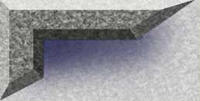|
Tamiya's 1/48th Bf109E-4, below. This model was built to represent
a machine from 2./JG-3 while the unit was based at Colombert, France in October 1940. By that time, jagdwaffe daylight
operations over Britain had been reduced to brief incursions by bomb-laden Messerschmitts, usually one staffel(jabo) escorted
by others from the same Gruppe.
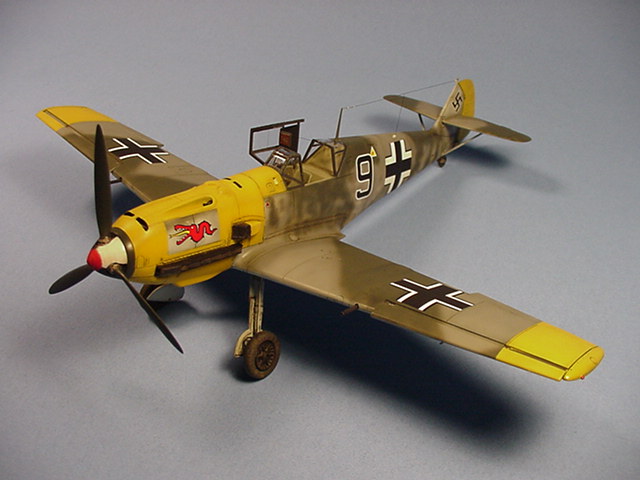
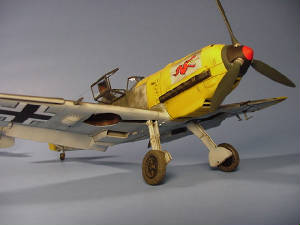
Decals were sourced from Third Group and Aeromaster. The upper surfaces of the model were painted to represent
the field applied greys, using Floquil's RLM 74 & 75, mixed with small ratios of British Dark Slate Grey and Intermediate
Blue, respectively. The underside is their RLM 76 Lichtblau, while the yellow recognition markings were RLM 04 with a few
drops of their Antique White. Leather covers in the wheel well are represented by tape, painted with Model Master Leather
Brown.
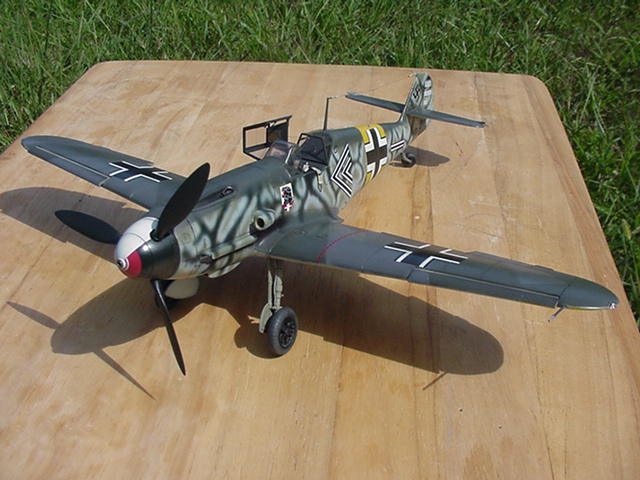
|
| Nobody makes decals for this one so I made the Staff markings from scratch |
I've always wanted a model of this machine in my collection. This is the
Hasegawa 1/32nd scale Bf109G-6 converted to an F-2 using the Aires conversion with numerous modifications to the Aires parts
to backdate them from their 109F-4 configurations. It represents the mount of Dietrich Hrabak, Kommandeur of II/JG54
while based at Rjelbitzi, USSR, in the summer of 1941. Hrabak was a pre-war pilot who, flying mostly with JG-54
and JG-52, mentored many of the Luftwaffe's top scorers. His conservative and focused leadership style resulted in the
survival of many of the new pilots and enhanced the striking power of his veterans. Such greats as Hartmann, Rall, Batz,
Barkhorn, Kittel, Novotny, Phillip, and Graf were numbered among his pupils. He was personally credited with 125 victories
and survived the war.
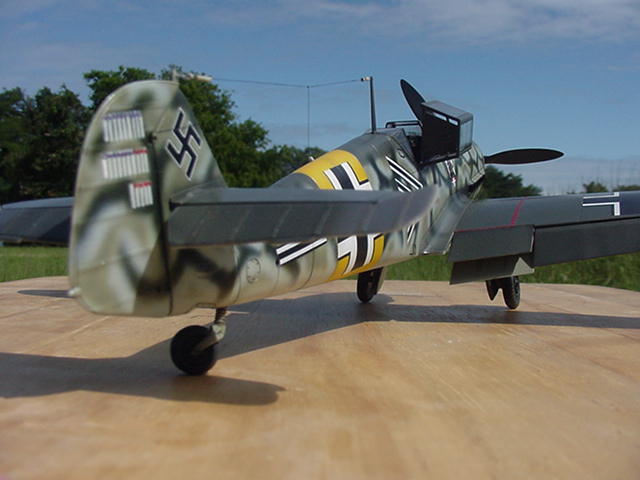
|
| These photos were taken behind the Prussian ramparts at the Yorktown National Battlefield |
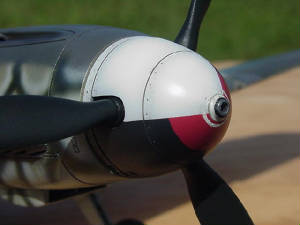
|
| The Eagle Editions spinner is a vast improvement over the kit parts |
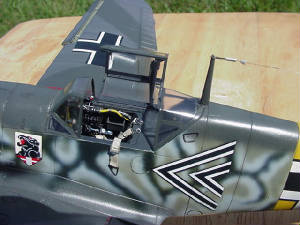
|
| The canopy was enhanced with framing made from stock styrene |
The Aires cockpit set consists of finely cast resin parts enhanced with photoetched metal seat straps, panel faces, levers,
and valve handles. Items added from scratch include the shoulder harness clamps, canopy truss, wiring for windscreen
lamps, and internal framing for the three clear pieces. The replacement spinner from Eagle Editions is in my opinion
the best in this scale.
The next four images are of a 1/32nd Promodeler Bf109G-4, backdated to a G-2 using a variety of kit spares
and a pair of True Details Bf109E mainwheels. It also features an MDC cockpit and canopy detail set, and Eagle Editions
spinner. This model is finished in the markings of Hpt. Hans Ehrler.

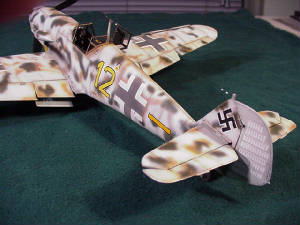
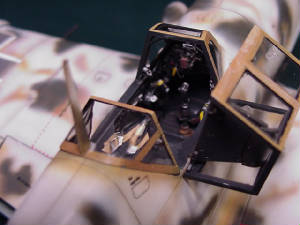
This scheme has caused arguments among modellers for over 60 years. Latest research strongly indicates that this
aircraft was originally on it's way to the Mediterranean in a tropical scheme RLM78/79, but was to diverted to Jagdgeshwader
5 at Petsamo, Finland in the spring of 1943. Overpainted with whitewash and green mottle, it was fitted as a Bf109G-2r6. This
machine was flown by the Kapitaen of 6. Staffel of II./JG5, Hpt. Hans Ehrler. Ehrler was a long-serving member
of the unit who was credited with 209 aerial victories and survived the war.

|
| Pilot harness was made from MDC buckles and blue painter's tape. |
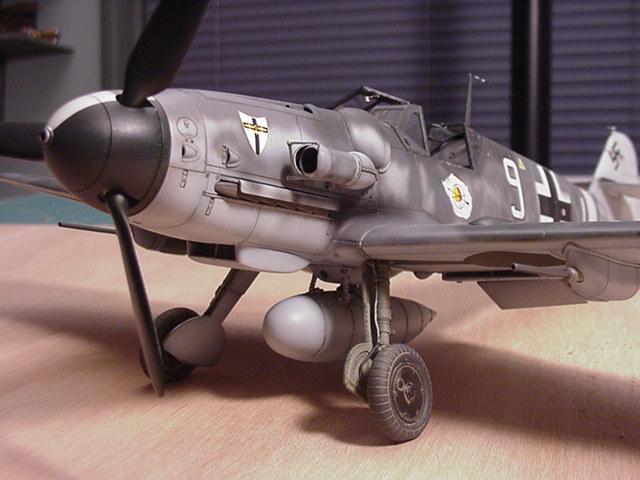
|
| This is Hasegawa's 1/32nd Bf109G-6 in the markings of 7./JG-27 |
"White 9" of 7./JG-27 was flown by Uffz. Rudolf Moycis, while stationed at Kalamaki, Greece in the summer of 1944. Credited
with 9 victories, Moycis lost his life in combat on October 12 of that year. I used the superb replacement spinner,
drop tank & rack from Eagle Editions and Cutting Edge's fine cockpit and exterior detail sets to spruce up this kit.
The CE Exterior Set provides tail surfaces, better armament, early and late tropical filters, exhausts, and a suite
of other well-rendered extras including four cowl scoops so you can correct their orientation on the kit.
The decals were from Eagle Strike- if you choose to use this set don't forget to trim off the black outline on the 7./JG-27
emblem below the cockpit. Their JG-27 badge was quite large compared to my photos of this machine, so I used the corresponding
decal from an Eagle Editions set.
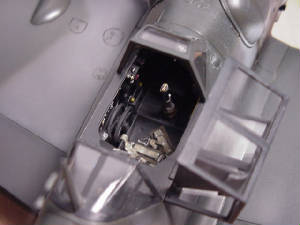
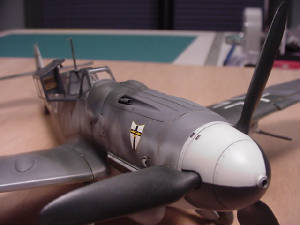
Next up is the 1/32 scale Hasegawa kit, with a substitute G-14 metal and fabric tall tail. Model includes scratchbuilt
extras and a partial MDC cockpit set. I had some spare sidewalls, so I scratched in detail refinements throughout the remainder.
Decals assembled from spares.
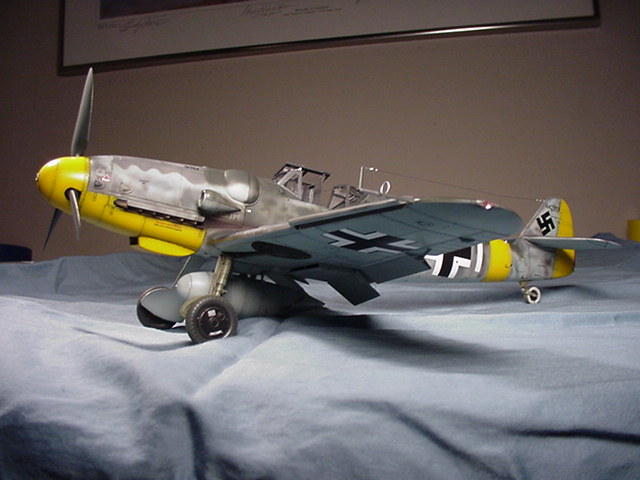
|
| Anton Hafner's Bf109G-6 with tall tail |
This model represents the machine flown by Lt. Anton Hafner, as photographed near Essen in the fall of 1944. At the time,
Hafner was Staffelkapitaen of 10./JG-51. Lt. Hafner served with JG-51 throughout his career and was credited with 206 victories scored
mostly over Russia and the Mediterranean. Hafner lost his life in a crash caused by his wing striking
a tree during a fast low level dogfight with P-38's on October 17, 1944.
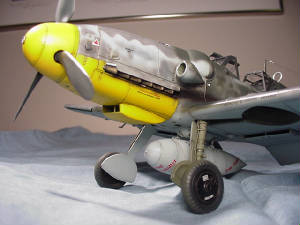
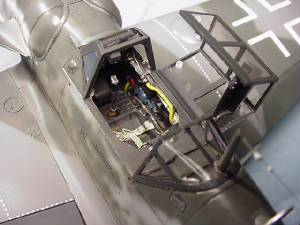
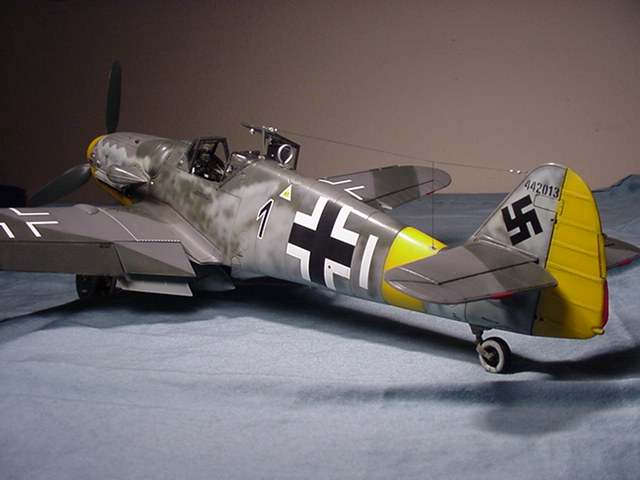
|
| Photos of this aircraft indicate a replacement cowl, hence the break in the camouflage |
Below is Hasegawa's 1/48th Bf109G-10, modified to represent a Bf109G-14/AS.
The plane depicted was flown by 23-victory ace Lt. Richard Franz while he was Staffelkapitaen of 7./JG-11 based
in Holland during the summer of 1944. Richard used his "Green 1" in a wild fighter vs. fighter combat on September
19, 1944 near Arnhem, Holland that pitted his vastly outnumbered Staffel against P-51D Mustangs of the 357th FG.
You can read a detailed account of this action written from both the American and German perspectives at www.cebudanderson.com
In this engagement Richard shot down a P-51, and then was hit heavily and forced
to crash land approximately 4 miles west of Vreden. He currently resides in Germany.
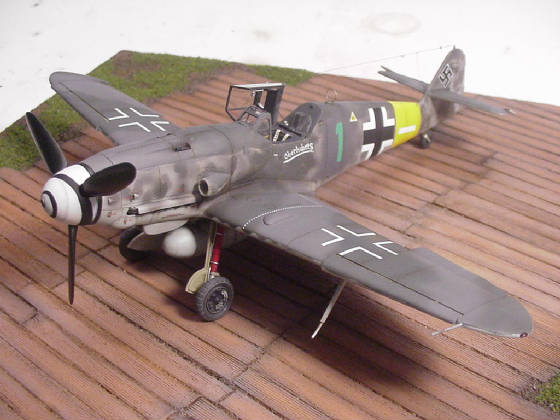
|
| The model is displayed on Just Plane Stuff's 1/48 Luftwaffe Plank Hardstand |
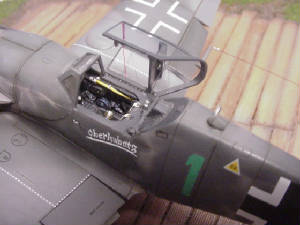
This view shows some of the cockpit features; the battery box cover behind the
seat and canopy retention mechanism were scratchbuilt. The loop antenna was scavenged from a DML kit. The cockpit
itself is a combination of Kendall resin and Airwaves photoetch metal parts. The moniker "Oberhubatz" appeared
only on Franz' plane- the others in 7./JG11 had "Hubatz" painted on them. The red dive angle indicators on the
canopy glass are painted synthetic hair held in place by a coat of Future floor polish.
Focke Wulf Images
DML's
1/48th Focke Wulf Fw190A-4 depicted as the machine of the Staffelkapitaen of 5./JG-1, Lt. Rudiger von Kirchmayr
while based at Hopsten-Rheine in the summer of 1943. I was more familiar with the Wurger flown by this pilot as JG-1’s Technical Officer, but a photo
in Eric Mombeek’s “Defending the Reich: The History of JG 1 Oesau” inspired me to try this machine. The photo caption describes the aircraft as an A-5, but my trusty magnifying glass
convinced me that it was most likely an A-4. Lt. Von Kirchmayr was credited with
46 victories and survived the war.

Luckily, I had some horizontal stabilizers and a CMK rudder in my spares so re-positioning the tail feathers
was a simple matter. The upper cowl was filled, sanded, and rescribed to correct
the shape and depth of the gun troughs and revise the positions of the Zu fittings above the panel line. Decals are from Third Group. Although I photographed the model
on Just Plane Stuff’s luftwaffe plank hardstand, I believe that the airfield at Hopsten-Rheine had a combination of
concrete and dirt taxiways.
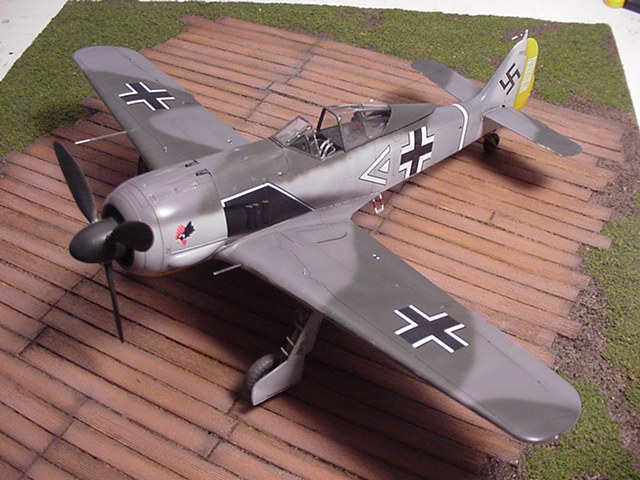
DML's 1/48th Focke Wulf Fw190A-5, finished as machine of the Kommandeur, III/JG-2, Maj. Egon
Mayer, while based at Beaumont-Le-Roger in the spring of 1943. Mayer flew combat from the opening days of
the war and was credited with 102 victories by March 12, 1944 when he was killed in action with P-47 Thunderbolts over France.
One
feature of III/JG-2 aircraft that I marvel at is the consistent adherance to marking protocols through most of the war. The markings on this machine are virtually identical to planes ranging from the Bf109F
and earlier Wurgers flown by both Hans ‘Assi Hahn and his successor, Egon Mayer. A
photo in Osprey’s book on JG-2 demonstrates that at some point this aircraft was fitted with high altitude gear including
the bulbous intakes on either side of the lower cowl. Checking other references
it appears to have been a field modification, so I decided to model mine with the standard cowl. With the help of JG-2 stalwarts Rudi Pflanz and Erich Leie, Maj. Mayer pioneered the head-on attack for
use against four engine bombers.
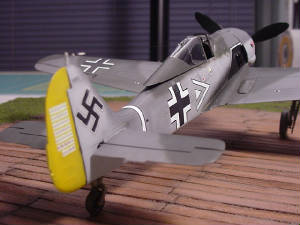
I used this kit as an opportunity
to try the replacement cowl from Cutting Edge and was rather pleased with the result.
Landing gear position indicators are .009 steel guitar string. Decals
are from Aeromaster. Photos of this and other III/JG-2 Fw190’s from the
period indicate that the fuselage mottling applied was quite subdued, appearing to be just a faint misting of RLM75 Grauviolet.
Next up is Hasegawa's 1/32nd scale Fw190D-9. For this model I used
the cowl correction parts and decals from Eagle Editions, please see the links section for their online store if you're interested
in these upgrades. Model represents "Schwarze 1" of 14./JG26. This aircraft was flown by Oblt. Hans Dortenmann
in March 1945 while stationed at Varrelbusch, Germany. All paints are either Floquil or Aeromaster Enamels.
RLM83 Lichtgrun and RLM82 Dunkelgrun are custom mixes from other Floquil colors.
On the Fw190, if you intend to display the canopy open then it is important to set the front corners on the canopy rails,
the front of the canopy was guided by a pair of casters and the flexibility of the perspex allowed it to squeeze
as it slid back. Also, the antenna wire was fixed on airframes having the blown canopy, so it should droop when
the canopy is open.
If memory serves, the aircraft featured below is known only from a series of photos of a pile of dismantled derelicts
at what appears to be a Luftgau maintenance and distribution facility after the war's end. It is believed to have been
"Gelbe 15" of JG-301.

Like Oblt. Dortenmann's Fw190D-9 featured earlier, this model received the Eagle Editions replacement hood and cowl parts
as well as their fine decals. The fuselage sky color is Aeromaster's RLM84 "Hielgrun"- specifications for this color
do not exist, but it can be viewed on the treloar Center Bf109G-6, which currently resides at the Australian War
Memorial. I finished the undersides of the wings in a hodgepodge of natural metal with RLM23 Rotbraun primer, RLM75
Grauviolet, and RLM76 Lichtblau as has been documented for some other airframes in the 500xxx production block. This
one was W. Nr. 500666.
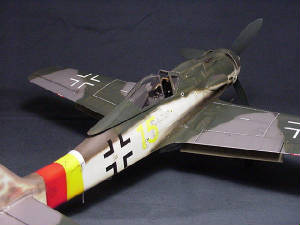
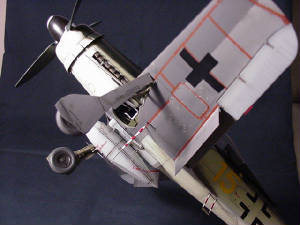
|
